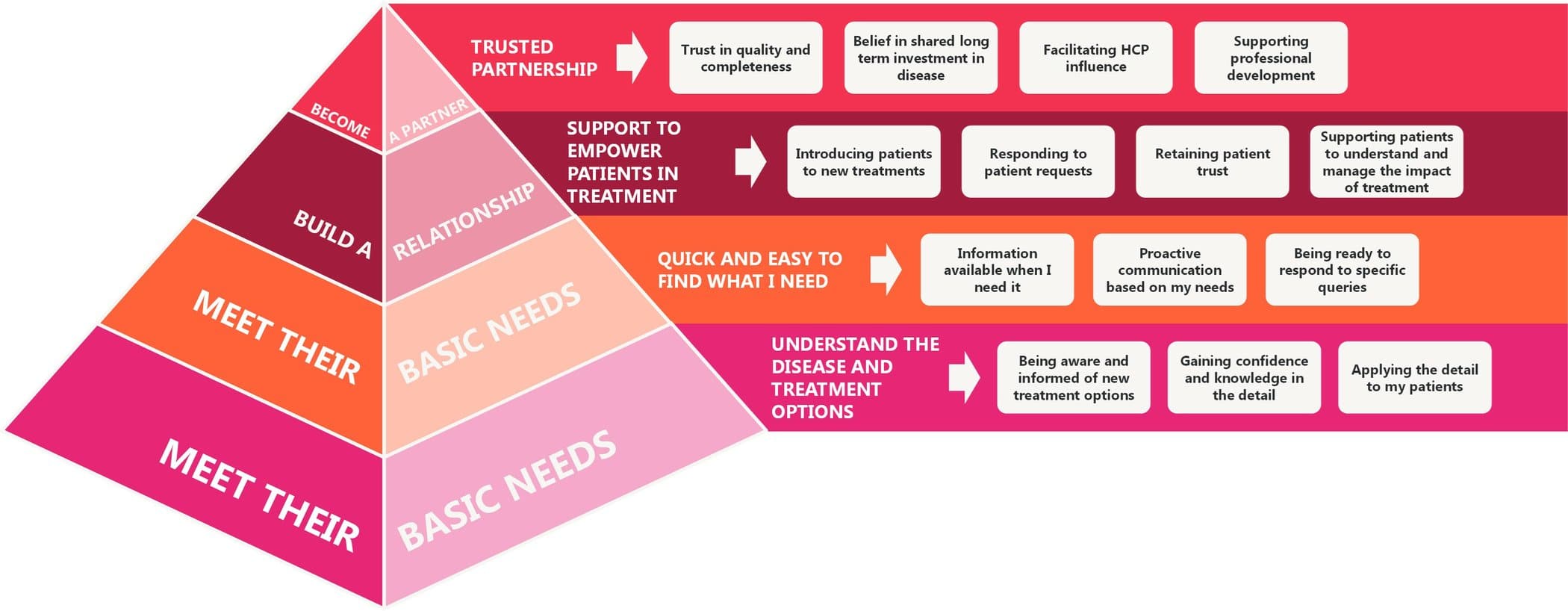Pharma often lags behind other industries when it comes to using digital as a channel to engage with customers. In fact, until the pandemic hit, there was still a comfortable reliance on using sales representatives and medical science liaisons (MSLs) on the ground to build face-to-face relationships with healthcare providers (HCPs). Multiple lockdowns, however, challenged commercial teams to work with their technology teams and rapidly seek innovative solutions to keep their customers engaged.
The challenges companies faced showed them just how much they needed their digital transformation programmes to deliver, it was no longer just a hard sell from the CTO.
As the opportunities to meet face to face return, digital needs to complement and even enhance human interactions with customers. Regardless of the channels used, HCPs and patients are expecting personalised experiences at scale.
The questions many are now asking on this steep learning curve are:
- What kind of future should we be aiming for?
- How can technology make a difference?
- How fast can we move?
What kind of future should we be aiming for?
Commercial teams need to design experiences that will help to build a sense of relationship with doctors and patients, by focusing on their needs rather than what digital can do.
Research shows that post product launch, how a company brand is perceived becomes the greatest factor in HCP decision-making. Company perception goes beyond excellent campaign targeting and is influenced by a sense of partnership with sales representatives, support to achieve professional goals, personalised communication, and frequency of engagement across a broad range of channels. Put simply, it’s about understanding and responding to HCP needs.
Figure 1 draws on market research to develop a hierarchy of HCP needs, creating a framework that commercial and medical teams can adapt to their context and then use to prioritise investments in tactics to engage HCPs.

Figure 1: Hierarchy of HCP needs
The best tactics need to be designed based on a deep understanding of customer needs and pain points. AbbVie have some strong examples in the market. For example, they use On24, a digital experience platform, to produce and support webinars for their HCPs and run informative non-branded Twitter campaigns to drive positive medical discussions.
How can technology and data make a difference?
Get ways of working across technology and commercial teams right from the start.
Starting with the commercial strategy, work with colleagues in technology to identify the ways you can enhance or accelerate goals. There is no digital strategy without a commercial strategy.
Getting into the detail, digital transformation programmes and omnichannel strategies need to start by being clear about the commercial value they deliver for the business. Establish shared KPIs and hold each other accountable.
Target personalisation at scale as you make use of a richer set of HCP data
Use your CRM systems to capture a richer data set about your customers (where regulations allow) so that you can use this to tailor the experiences you design and execute for them. Your sales representatives and MSLs will be a great source of information. Look for opportunities to build on their insights with marketing engagement tracking (which emails did they read and click through on?), HCP portal data (what did they engage with and why?), event data (which events did they attend and who did they connect with?) and third-party data sources like social media engagement.
As you build a 360-degree view of your customers, you can begin to take advantage of AI and automation to make it easier for your marketing and sales teams to apply insights in the day-to-day actions they take. Good use cases could be:
- Optimising frequency of interactions by channel.
- Identifying interactions and tactics with the highest impact.
- Automated tailoring of content shared with HCPs based on preferences.
- Establishing account reviews to assess the impact of tactics relative segments and archetypes.
Engage your customers through digital channels
Research shows that face to face time with sales representatives still has the greatest impact, but there is an opportunity for you to complement these interactions through digital engagement.
For example, as shown in Figure 2, recent data collected for dermatologists identified preferences for:
- patient support and patient apps.
- informative educational events and products like. webinars, conferences and eMedical education (interestingly online conferences were seen to be equally effective as in person).
- pharma apps and websites.
How fast can we move?
It’s important to start by setting a realistic minimum viable digital set up that your markets can meet
Recognise that for some, the first step is simply going to be setting up a better digital portal for HCPs or creating a suite of emails targeted at HCP segments.

Figure 2: Channels to complement sales representative interactions
Figure 3 represents a good baseline for markets early on in their transformation journey. Key features are:
- digitally-supported representative selling (virtual meetings and CRM tools)
- multichannel marketing using universal messages & basic digital channels
- basic insights to analyse commercial activities

Figure 3: Minimum commercial digital capability (Source: Gate One)
Start by designing target customer journeys and mobilise teams to deliver these before you start automating or using AI
Often there is a great deal of time spent designing next best action tools, but a quick win would be to create a suite of target customer journeys that describe the integrated experience you will deliver for a customer. This work doesn’t require much investment and is a quick way to establish integrated plans across commercial, medical, patient experience and internal capability teams to make sure that everyone is focused on what is best for the customer before you switch to automation.
Some examples of journeys you could create for your HCPs include on-boarding a patient for the first time, switching treatment options and attending continuing educational events.
Don’t be afraid to innovate – and try new tactics before scaling globally
Use ‘design-thinking’ approaches to look at ways you can delight your HCPs and patients and target existing pain points. With small investments at a market level, you could design new digital tactics, learn from small-scale testing, and then create an ‘adapt-and-adopt’ process to scale across multiple geographies.
Focus on what your customers and team need
Investing in digital has huge potential to improve the way pharma companies engage with HCPs and patients, but to be successful, digital transformation programmes need to create strong connections with commercial and patient experience teams to ensure the value of new ways of working and digital tactics are prioritised based on customer insights and what will help existing teams. It’s great to be ambitious in the plans you create but start with getting basic digital capability in place and creating small innovative tactics to test. As always, return on investment will rely on people rather than technology – be clear on what your customers really want from you and engage your workforce early.
This article was first published in European Pharmaceutical Manufacturer on 29 November 2021.
Find out more about Gate One’s work in the Life sciences sector and how we’ve driven global growth through digital for pharma businesses.

